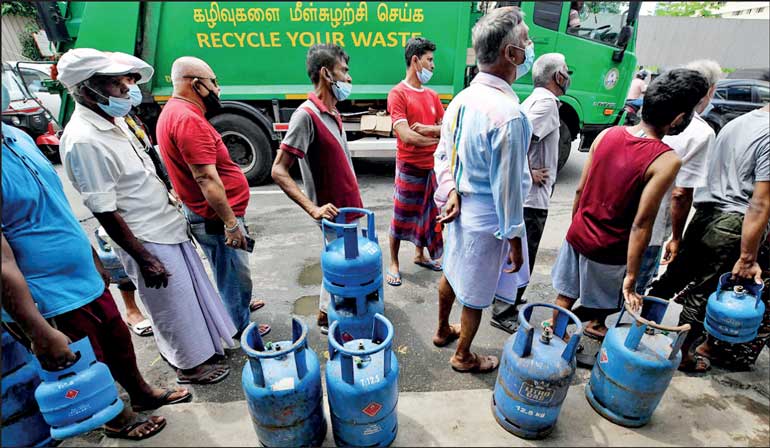Tuesday Dec 16, 2025
Tuesday Dec 16, 2025
Friday, 25 November 2022 00:00 - - {{hitsCtrl.values.hits}}

While Sri Lanka is hit by its worst-ever crisis in its history, it is also a golden opportunity for key reforms which will lead to sustainable recovery and inclusive economic development – Pic by Shehan Gunasekara
“Never let a good crisis go to waste” – Winston Churchill

While the world is facing a soaring inflation and at the brink of global food crisis, what Sri Lanka faces is more than an economic crisis – a Balance of Payment crisis where our forex reserves have dried up, a debt crisis where largest portion of foreign debt is held by commercial institutions rather than concessionary lending from World Bank or Asian Development Bank, a financial system crisis where high government lending exposure by the Sri Lankan financial system, a political crisis where public outcry over corrupt governing systems and structures and a humanitarian crisis directly impacting food security, health and education.
The seems-like back to normal bubble that we witness in the commercial capital of Sri Lanka and the false-sense of security soon vanishes when we reach the rest of the country which represents more than 90% of the population. This represents the inclusive growth we as a nation have failed to achieve after 74 years from independence and 13 years after the end of the civil war, resulting in persistent regional inequality.
Though the previous regime and its policy failures are blamed for the pace at which the crisis has hit us, the cause roots back to subsequent governments since independence. Sri Lanka has recorded a primary surplus (the excess of government revenues over non-interest spending) only 4 times in 74 years since independence. We have continuously lived beyond our means as a nation. Development projects were largely non-revenue generating or non-dollar revenue generating and were financed by short-term borrowing at higher interest rates.
Until consensus with creditors on debt restructuring is reached and IMF bailout is received which will eventually pave the way to open-up more credit lines for Sri Lanka such as from the World Bank and Asian Development Bank (ADB), securing bridge finance is pivotal. When new lines of credit open-up, accountability measures to ensure transparency and to have checks and balances and austerity by means of tax reforms and expenditure management will be required. Environmental conservation arrangements like debt-for-nature swaps which Sri Lanka is currently exploring with the assistance of United Nations Development Programme (UNDP) and other agencies would result in win-win solutions towards the way of debt relief.
While Sri Lanka has been on IMF bailout 16 times since 1965, we have continuously sought re-financing as a way out resulting in this vicious cycle of debt which has brought the island nation to default for the first time in its history. Sri Lanka has not serviced its debt since April 2022 and experts say it’s inevitable for the queues to return and the crisis will be hard felt again when Sri Lanka starts servicing its debt. While Sri Lanka is hit by its worst-ever crisis in its history, it is also a golden opportunity for key reforms which will lead to sustainable recovery and inclusive economic development.
Vietnam, which is considered to be one of the stars among emerging economies with exports worth almost equal to its total GDP and economic growth of 6-7% which rivals China – ended its 20-year war in 1975. The success of this Southeast Asian nation which steered it to become socialist-oriented market economy is attributable to the series of economic and social reforms introduced in 1986. Vietnam’s economic rise is explained by three main factors: trade liberalisation, domestic reforms through deregulations and lowering cost of doing business, and heavy investment in human and physical capital largely through public investments.
Vietnam has 26 free trade agreements in place covering most of the major economies in the world such as with ASEAN, World Trade Organization, with the US, Trans-Pacific Partnership etc. leading to lower tariffs on both imports and exports. China and the US remain Vietnam’s most important partners in terms of economics, politics and security – Vietnam’s balanced strategy to manage world’s major political rivals as well as superpowers is a key learning Sri Lanka should seek to master. Reforms were mainly centred on consistency and stability seeking a more pro-investor approach while aiming to reduce administrative bureaucracy and to facilitate foreign direct investments (FDI).
Vietnam’s public investments were mainly directed to the development of human capital and infrastructure. Large public investments were made in primary education as well infrastructure ensuring cheap mass access to the internet to prepare well for the fourth industrial revolution. Sri Lanka should well seek to optimise its limited public funds to areas of education and development which will lead to high value creation and economic development, rather than directing the funds to expenditures which aren’t justifiable.
Vietnam has become a hub for foreign investments and manufacturing in Southeast Asia. Vietnam is one of the largest exporters in electronics, apparel and agricultural produce like coffee and rice in the region. This Southeast Asian nation was soon able to build their own technical know-how with the learnings from global giants. Multinationals consider Vietnam as the best alternative to diversify due to the supply-chain pressure caused by China’s zero-COVID lockdowns due to its cheap labour, geographic proximity to China and political stability. Vietnam is becoming increasingly important in the semiconductor supply chain which is considered to involve more complex production with investments from Intel, Samsung and Synopsys capitalising on the supply chain constraints caused by China.
Sri Lanka to emerge globally competitive, export diversification and privatisation of State-Owned Enterprises with commercial interests to trigger competition is essential. While more value-adding ways to boost traditional exports need to be devised, Sri Lanka should prepare for the fourth industrial revolution by leveraging its talent and tackling the mass brain drain. While Sri Lanka expects to activate its several inactive trade agreements such as with Singapore which will gain access to ASEAN which is one of the largest and most important free trade areas in the world, tariff rates which remain one of the highest in the region require to be relaxed to lead the way towards openness from protectionism.
Sri Lanka’s tax revenue-to-GDP ratio which was down to 12% in 2019 from nearly 20% in 1990, dropped to 8% in 2021 – one of the lowest in the world. Direct taxes contribute to less than 2% of GDP and only 1% of the population comes under the income tax base. Current crisis provides an opportunity to carry out reforms which could not have been attempted before amidst the populist policies in place – which could be a silver lining of Sri Lanka’s worst crisis in history.
(The writer is a finance professional with interests in finance, business, and current affairs, and can be contacted at [email protected].)